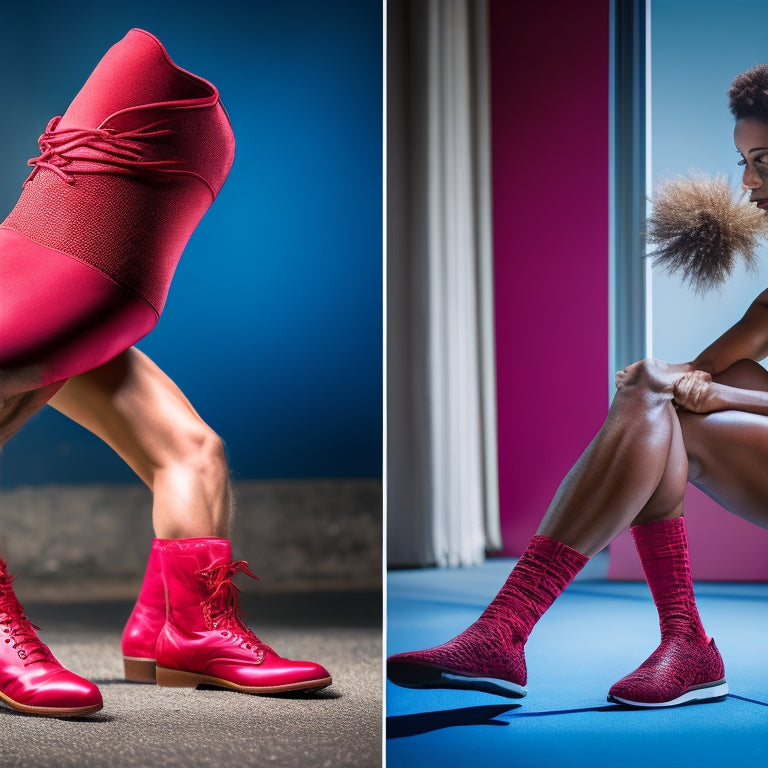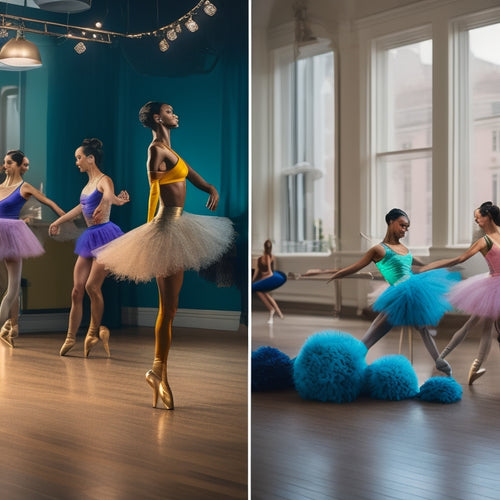
Avoiding Foot Injuries: Dance Tips Unveiled
Share
As a dancer, understanding the risks of foot injuries is essential for a healthy career. Approximately 80% of professional ballet dancers experience foot problems, underscoring the importance of prevention and proper care. Orthotics and exercises can reduce the risk of injury, with devices stabilizing the arch and exercises strengthening intrinsic foot muscles. Debunking myths and misconceptions is crucial, as ignoring early signs of pain can lead to severe injuries. Recognizing the signs and taking proactive steps can prevent debilitating foot injuries. By exploring further, dancers can uncover essential tips and strategies to safeguard their foot health and optimize their performance.
Key Takeaways
• Approximately 80% of professional ballet dancers experience foot injuries, highlighting the importance of prevention and proper care.
• Strengthening intrinsic foot muscles through exercises can reduce the risk of foot injuries and alleviate symptoms.
• Wearing poorly fitting shoes can exacerbate foot problems, and dancers should prioritize proper footwear for their specific foot type.
• Ignoring early signs of pain can lead to severe injuries, and dancers should address discomfort promptly to prevent further damage.
• Custom orthotics and gentle exercises can aid in healing and prevent future injuries, fostering a proactive approach to injury prevention.
Understanding Foot Injuries in Dance
Approximately 80% of professional ballet dancers will experience a foot injury at some point in their careers, highlighting the importance of understanding the common types of foot injuries that can occur in dance.
As dancers, it is essential to acknowledge that foot injuries can be debilitating and potentially career-ending. Poor muscle strength is a common culprit, leading to injuries ranging from mild to severe.
Injury prevention and proper foot care are indispensable in mitigating these risks. By adopting preventive measures and prioritizing foot care, dancers can reduce their likelihood of sustaining injuries.
This understanding is crucial in fostering a proactive approach to injury prevention, ensuring a longer and healthier dance career.
Prevention Through Orthotics and Exercise
By incorporating orthotics and exercises into their training regimen, dancers can greatly reduce their risk of foot injuries, thereby protecting their careers and promoting a longer, healthier dance career. Orthotic devices can stabilize the arch and alleviate symptoms, while exercises can strengthen the intrinsic foot muscles that control foot arch position and toe movement.
Gentle exercises aid in healing and prevent future injuries, and custom orthotics can be recommended for daily shoes. Foot strengthening exercises, such as those found in The Perfect Pointe Book, are essential for dancers recovering from foot injuries. By combining orthotics and exercises, dancers can effectively prevent foot injuries and maintain excellent foot health.
This proactive approach to injury prevention is vital for a successful and injury-free dance career.
Dispelling Myths and Misconceptions
While incorporating orthotics and exercises into their training regimen is an important step towards preventing foot injuries, dancers must also be aware of common myths and misconceptions that can hinder their progress and put their careers at risk.
Debunking myths and misconceptions is vital for effective injury prevention and foot health.
-
Dancers should not ignore early signs of pain, as it may lead to severe injuries.
-
Wearing shoes that fit poorly or provide inadequate support can exacerbate foot problems.
-
Foot injuries are a normal part of a dancer's career, and accepting this myth can lead to complacency and neglect of preventative measures.
Frequently Asked Questions
Can I Wear Orthotics With Pointe Shoes?
"Surprisingly, ballet slippers don't accommodate orthotics, but that doesn't mean you're doomed to poor arch alignment. Consult a podiatrist for supportive materials and taping techniques to promote proper alignment, ensuring a harmonious dance between foot and floor."
How Often Should I Replace My Dance Shoes?
'Regularly inspect and replace dance shoes every 3-6 months or after 50-70 hours of use, depending on dance mileage, to maintain essential support and prevent injuries, making shoe maintenance a vital aspect of dance care.'
Are There Exercises to Strengthen Ankle Stability?
To strengthen ankle stability, incorporate exercises like ankle circles, single-leg balances on balance boards, and calf raises to improve proprioception, reducing the risk of ankle sprains and promoting peak dance performance.
Can I Still Dance With a Stress Fracture?
As a delicate petal cracks under the weight of a dancer's step, so too can a stress fracture shatter the rhythm of a performer's career. Fracture management demands a meticulous mindset, prioritizing rest and rehabilitation to guarantee a triumphant return to the stage.
Do I Need to See a Podiatrist for a Minor Foot Sprain?
For a minor foot sprain, consulting a podiatrist is essential to assess sprain severity and foot anatomy, ensuring proper diagnosis and treatment to prevent further injury and promote best possible recovery for dancers.
Related Posts
-

Best Dance Footwear for Comfort and Performance
When selecting the best dance footwear for comfort and performance, prioritize shoes with exceptional arch support an...
-

Sydney Street Dance Study Sparks Community Revival
In Sydney, a thriving street dance scene has revitalized the city's parks, streets, and studios, fostering a profound...
-

Frozen Frenzy: Creative Crafts Galore
We're entering a winter wonderland of creativity, where snowflakes sparkle, ice castles shine, and magic unfolds in e...


